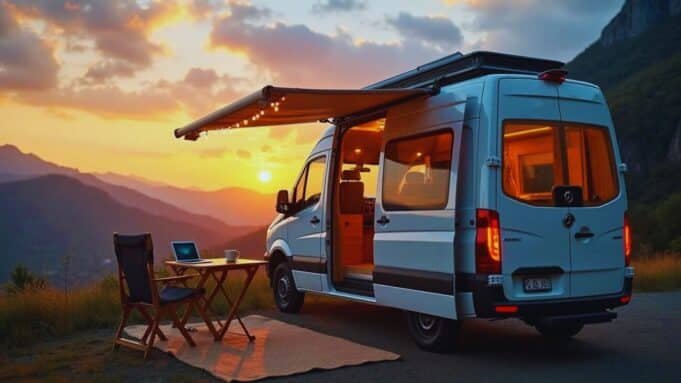Van life has seen a remarkable rise in popularity across Europe, with global searches for “vanlife” growing by 22 percent each year and now reaching over 90,000 monthly searches worldwide. But this movement is more than just a social media trend. In the United States alone, the number of people embracing van life has jumped from 1.9 million in 2020 to more than 3 million today, many of whom take their mobile homes on adventures through Europe.
What began as an alternative travel option has evolved into a full-time lifestyle for a growing number of people. Today’s vans are fully equipped homes on wheels, with monthly living costs ranging from $800 to $2,000, comparable to the cost of renting a traditional apartment. With its well-connected road systems, stunning scenery, and camper-friendly infrastructure, Europe has become a favorite destination for modern nomads.
The shift toward remote work has played a major role in this lifestyle change. In the U.S., the number of remote workers has soared from 9 million in 2019 to 35 million in 2024. Studies show that 93 percent of remote professionals report better mental health, and 90 percent say their physical health has improved as well.
In this article, we’ll explore the real story behind van life in Europe—from day-to-day challenges and unexpected costs to the unique sense of community that often goes unseen behind the perfect Instagram shots.
Why Van Life in Europe Is More Than Just a Trend
Van life in Europe has become more than a fleeting trend because it taps into something deeper. It speaks to the human desire for movement, independence, and meaningful experiences. This way of living challenges old ideas of what home and work should look like, offering a lifestyle that blends adventure with intention.
As more people embrace this path, the reasons behind its rise become clearer, reflecting broader shifts in how we think about comfort, purpose, and connection.
The Move From Vacation to Lifestyle
Life on wheels has reshaped the scene dramatically. What started as a different way to vacation has grown into a complete life philosophy. People don’t just visit Europe in their vans anymore. They make these vehicles their permanent homes. Recent numbers show more than 3 million Americans now live in vans, up from 1.9 million in 2020.
This lifestyle change runs deeper than temporary travel. Many van dwellers say they “choose a lifestyle of freedom, adventure, and connection with diverse landscapes and cultures”. The community makes this change last.
How Remote Work Fuels the Movement
Remote work powers this mobile revolution. A van lifer puts it best: “The most important benefit of remote technology work is the freedom to do your job from anywhere with an internet connection”. This freedom brings real benefits. Remote workers save 55 minutes each day by skipping commutes.
Technology that supports this lifestyle has grown better. Starlink satellite internet now gives reliable connections almost everywhere. Modern battery systems like EcoFlow let vans run completely off-grid without hookups. Co-working spaces have popped up all over Europe. These spaces charge around €12 daily for stable WiFi and comfortable work areas.
The Appeal of Minimalism and Freedom
Van life naturally leads to minimalism. Small spaces make you question every item you own: “With limited space, you’ll focus on what’s essential, which can help you feel more free and less cluttered”.
Simple living gives you a fresh viewpoint. You live with less but gain more in return. One van dweller shares: “It’s surprisingly freeing to have less and to realize you don’t need to have immediate access to everything”.
Freedom remains the biggest draw. You can chase good weather, work from mountain peaks, or wake up next to the ocean. You might just change locations whenever you feel like it. Van life lets you control your schedule and surroundings in ways that traditional homes simply can’t match.
What Living on Wheels in Europe Really Looks Like
Living full-time in a van across Europe comes with a unique rhythm. The freedom is real, but so are the daily decisions that shape the experience. Every journey requires flexibility, preparation, and a willingness to adapt. The reality often feels far removed from the polished photos and curated videos. Once the road becomes your home, even simple tasks take on new meaning and importance.
Daily routines and unexpected challenges
Life in a van isn’t exactly what you see on Instagram. The daily grind involves simple tasks like finding water, dealing with waste, and keeping the temperature right. Summer turns these vans into rolling ovens. Winter brings its own headaches with condensation problems, whatever insulation you have.
Getting sick in the middle of nowhere is a real concern for van dwellers. Most experienced travelers pack simple medications and keep track of pharmacy locations throughout their experience. The language barrier makes simple tasks tough. You might end up using chewing gum to fix a leaking sink hose in Norway!
How people actually live in vans
Most van dwellers live on tight budgets – about £25 a day covers food, gas, tolls, and camping fees. Living off the grid becomes crucial. Many people invest in solar panels, leisure batteries, and good water storage.
Remote work in Europe comes with its own set of challenges compared to America. The US has coffee shops everywhere with great internet. Europe’s cafes don’t like laptop workers hanging around all day. Internet connection quality changes a lot depending on where you are. Digital nomads often have to rely on mobile data alone.
The reality of finding places to park and sleep
Finding safe and legal overnight spots is the biggest problem van dwellers face each day. Rules change from country to country. Portugal and Norway welcome wild camping thanks to their “Right to Roam” laws. Croatia takes a different approach with heavy fines for illegal camping.
Europe’s strong infrastructure helps van dwellers:
- France has “Aires de Services” in almost every town
- Germany’s “Stellplatz” spots are perfect for motorhomes
- Italy provides “Sostas” for overnight stays
Park4Night and Campercontact apps are a great way to get GPS-located parking options. They come with user reviews, photos, and details about facilities. Experienced van dwellers follow a simple code: show up late, leave early, and never leave a trace behind.
The Hidden Costs and Logistics Nobody Talks About
Most newcomers get shocked by the financial reality of van life in Europe. Those dreamy Instagram posts hide a complex web of expenses that could make your mobile lifestyle unsustainable.
Original van conversion and setup costs
You just need a substantial upfront investment for van life. A reliable base vehicle costs between £8,000-£12,000. Post-2013 models work best to avoid rust problems. The conversion costs vary a lot—some people manage with £500, while quality builds typically range from £15,000-£20,000. My experience shows that cutting corners on essentials like electrical systems can be dangerous. A vanlife blogger’s cheap £80 inverter actually exploded and almost caused their vehicle to catch fire.
Ongoing maintenance and repairs
Reality hits hard when it comes to maintenance. One van dweller spent a whopping £2,351 on repairs in just one year. Their expenses included £502 for a new cam belt and £809 for brake components. The problems are systemic—leaking gas systems, faulty water tanks, and lifted flooring give van dwellers constant headaches.
Insurance, tolls, and legal requirements
Different rules in each European country make compliance tricky. French authorities charge a £90 fine without warning triangles and hi-vis vests. German roads demand environmental stickers for city access and DIN-standard first aid kits. Spanish regulations require two warning triangles instead of one. Border-crossing travelers rack up toll charges quickly—one person paid €140 crossing French highways in a single day.
To stay on the safe side, many van lifers turn to services like Cosmote Insurance to make sure they’re properly covered as they move through multiple countries with varying requirements.
Budgeting for fuel, food, and campsites
Your monthly expenses change based on how much you travel and your lifestyle choices. Food costs run €250-€338 monthly. Fuel expenses range from €100 €322 depending on your travel distance[181]. Campsite fees vary between free Aires in France and €32 nightly at premium spots. Experienced travelers budget €400-€1,346 monthly. That’s nowhere near traditional housing costs but still demands careful planning.
Community, Connection, and the Social Side of Van Life
The UK alone has over 500,000 touring vans, and this thriving community welcomes newcomers with open arms. Van life brings more than just practical challenges – it opens doors to a vibrant social world that many first-timers don’t expect.
How to meet other van lifers
Some of the best van life moments happen when you least expect them. You might pull into a rest stop between the Spanish coast and French countryside, and suddenly find yourself in the middle of an impromptu international gathering. These spontaneous meetups go beyond sharing meals – they become sessions where people swap stories, wisdom, and practical tips that make life better on the road.
Van enthusiasts across Europe come together at yearly events. Spain’s Furgoperfectos draws crowds with its workshops and presentations. The world’s largest off-road fair, Abenteuer & Allrad, takes place in Germany. British van lovers gather at Worcestershire’s Busfest to celebrate everything VW. These events turn ordinary venues into buzzing hubs where friendships bloom.
Online groups and ground meetups
The digital world makes finding your van life tribe easier than ever. Groups like “Van Life – UK” and “Motorhome Adventures” on Facebook let you ask questions and connect with fellow nomads. Country-specific groups are a great way to get local knowledge about rules and hidden spots when traveling through Europe.
Communities like r/vandwellers and r/vanlife on Reddit help with everything from insulation tips to travel routes. Instagram tags like #vanlife and #homeiswhereyouparkit showcase stunning vans and help you find potential friends.
These communities create deep bonds quickly. One van lifer puts it perfectly – you can have “meaningful connections & have a deep conversation within 5 minutes of laying eyes on them”. This happens naturally because everyone shares core values and interests, letting you skip the small talk and dive into what matters.
MeetUp helps you find support groups and share interests with like-minded people if you want face-to-face connections. Apps like Nomad Near Me show you other nomads nearby, perfect for organizing impromptu gatherings under starlit skies.
Conclusion
Van life in Europe offers far more than scenic road trips and photo-ready sunsets. It’s a lifestyle built on adaptability, resourcefulness, and a deep appreciation for freedom. While the challenges are real—from maintenance costs to finding safe places to park—the rewards often outweigh them. Living on wheels teaches you to value the essentials, connect with like-minded people, and wake up each day with a sense of possibility.
For those willing to embrace the unexpected, van life can open doors to experiences that traditional living rarely provides. It’s not always easy, and it’s not perfect, but for many, it’s the most authentic way to explore the world while staying grounded in what truly matters.















